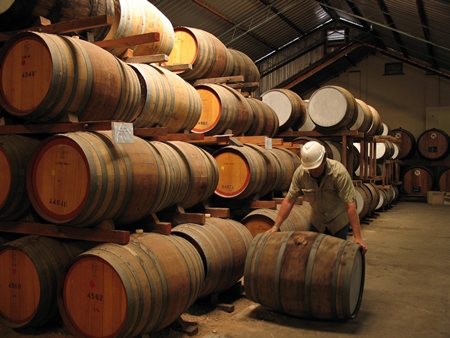If there’s one wine in the world that is under-appreciated outside its home country, it is Sherry. For a long time in Britain, Sherry was always regarded as the preserve of country vicars and maiden aunts. In Spain, it has always been the preferred drink of bull-fighters.
Let’s start with a quick take on Sherry, in case you are unfamiliar with this most misunderstood of wines. Now, please try to pay attention, especially those of you shuffling about in the back row. (1) Jerez de Frontera is the biggest and most important of the three towns in Andalucía that produce Sherry. (2) There are basically five types of Sherry, ranging from bone dry to staggeringly sweet. However, most Sherry sold today is dry. (3) Nearly all Sherry comes from the white Palomino grape. (4) Sherry should always be stored and served cold. (5) It differs from white table wine in that it’s fortified with extra alcohol during the production process. (6) There is normally no such thing as Vintage Sherry, because with very rare exceptions, new Sherry is always blended with older wines.
 Part of Angove’s fortified wine solera system.
Part of Angove’s fortified wine solera system.
The finest Sherry comes from companies like Croft, Sandeman, Domecq, Hidalgo, Lustau and González Byass (makers of the renowned Tío Pepe). In this fair city, you’re usually limited to Tío Pepe or Sandeman’s “Dry Fino”. Fino is the driest of Sherries, followed by the slightly sweeter and richer Amontillado, currently enjoying something of a revival.
The name Sherry derives from Jerez. In Shakespeare’s time, it was known as “Sack” although it probably didn’t taste much like the sherry of today. In George Rainbird’s book on the subject he writes, “As every schoolboy knows, sherry was Falstaff’s favourite tipple.” These days, I doubt whether many schoolboys would know who Falstaff was, let alone his drinking habits. But perhaps Mr. Rainbird didn’t know very many schoolboys.
Consistency in Sherry is achieved by blending wines from successive years in an extensive range of barrels known as a solera. After blending, something strange happens. As the new wine waits in its cask, a layer of natural yeast (called “flor”) develops on the surface and protects the wine from oxygen. This phenomenon occurs almost nowhere else in the world.
Bookmark Dry Sherry, Australia (Villa, Bt. 362)
This comes from Angove Family Winemakers, a well-established Australian wine company. Although the name “Sherry” appears on the label, it won’t be there for long. Matt Redin, the Marketing Manager for Angove told me that “with the new EU rules regarding nomenclature…we are no longer able to call it Sherry, but have adopted the term Dry Australian Fortified wine. The wine in the bottle will be exactly the same.” It’s an extremely pleasant wine too and at this price, quite a bargain. Like its Spanish cousins, it’s made using the solera system. With a light straw colour, the wine has a rich nutty aroma with almonds, marzipan, raisins, a hint of yeast and orange peel. The taste is full and fruity with raisins and sultanas. It has a very soft – almost unctuous – mouth feel with virtually no acidity. There’s an excellent long finish, with floral overtones and hints of orange.
The wine is not as dry as a typical Spanish Fino and its rich buttery fruit reminds me more of an Amontillado. Compared to Tío Pepe, this wine is fuller, softer and slightly sweeter. Wine critic Peter Forrestal described it in true Ozzie fashion as “bloody good”.
Custer’s Fino Dry Sherry, Spain (Foodland, Bt. 399)
Bottled in Jerez, this gold-coloured wine is several shades darker than the Bookmark. Surprisingly, it’s much lighter in body, noticeably drier and a dash more acidity. You’ll probably detect raisins, almonds and olives on the aroma, along with delicate hints of white fruit. The wine has a very long dry finish and is really rather elegant. If you prefer a typical dry fino, especially as an apéritif, you’ll probably enjoy this wine. It’s a bit lighter in body than Tío Pepe. Incidentally, Friendship sells Tío Pepe for just over a thousand baht, but there are other supermarkets further north that will be pleased to charge you an extra 300 baht for the same thing.
If you don’t normally drink Sherry, do give it a try some time. I have always loved it since my first tentative sip. Tentative, because I was only eleven at the time.




